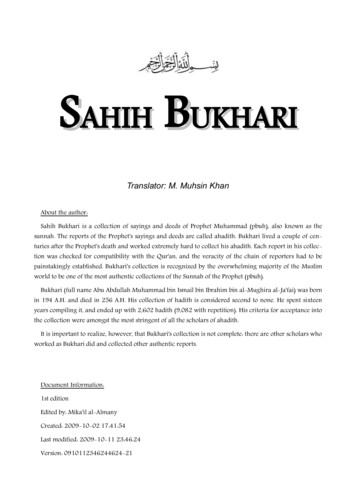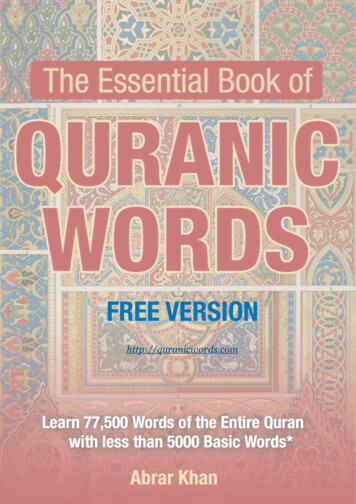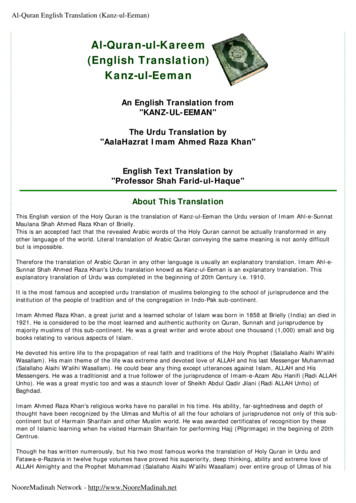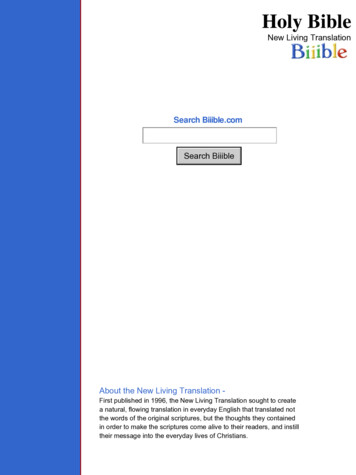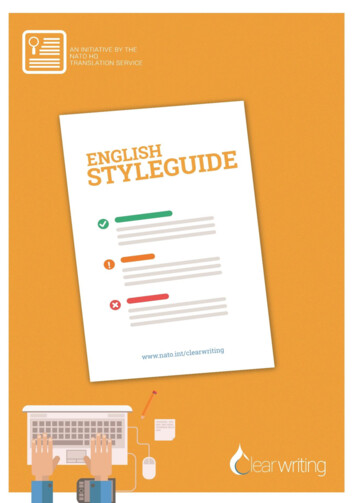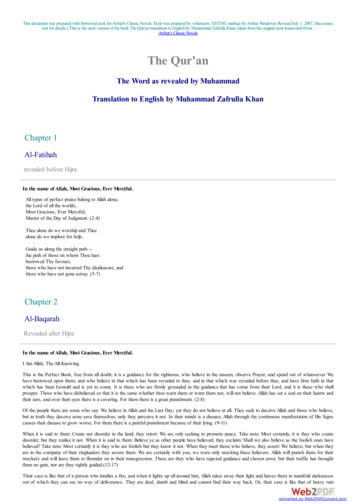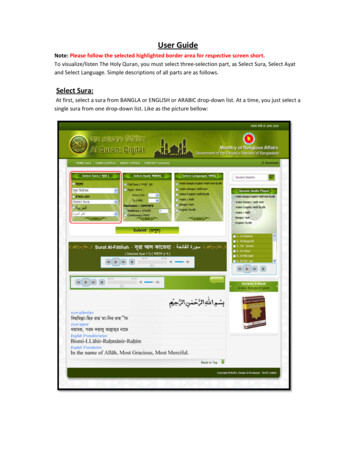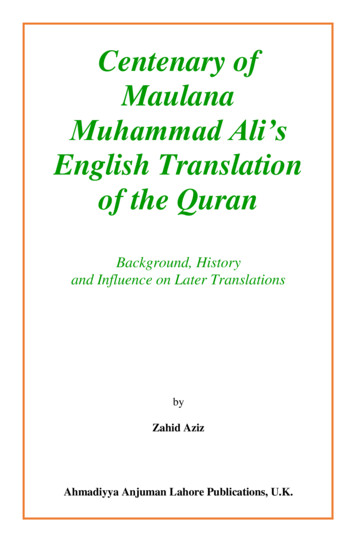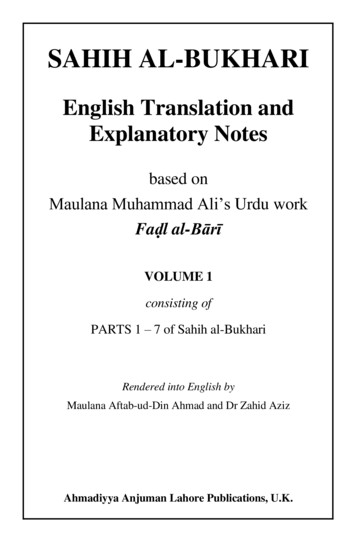
Transcription
SAHIH AL-BUKHARIEnglish Translation andExplanatory Notesbased onMaulana Muhammad Ali’s Urdu workFaḍl al-BārīVOLUME 1consisting ofPARTS 1 – 7 of Sahih al-BukhariRendered into English byMaulana Aftab-ud-Din Ahmad and Dr Zahid AzizAhmadiyya Anjuman Lahore Publications, U.K.
SAHIH AL-BUKHARI,ENGLISH TRANSLATION ANDEXPLANATORY NOTES
Sahih al-BukhariEnglish Translation andExplanatory NotesBased on the Urdu workFaḍl al-Bārīby Maulana Muhammad AliVolume 1:Parts 1 – 7 of Sahih al-BukhariCovering the fundamentals of IslamRendered into English byMaulana Aftab-ud-Din Ahmad and Dr Zahid AzizAhmadiyya Anjuman Lahore Publications, U.K.2019
A LAHORE AHMADIYYA PUBLICATIONDate of first publication of various parts:Part 1, in print, 1956Part 2, in print, 1962Part 3, in print, 1973Part 4, online, January 2016Part 5, online, May 2016Part 6, online, October 2017Part 7, online, June 2018Parts 1–3 revised, online, June 2019Entire work revised for publication, October 2019Copyright 2019 by Ahmadiyya Anjuman Lahore FoundationDarus Salaam, 15 Stanley Avenue, Wembley, U.K., HA0 4JQWebsites: il.cominfo@ahmadiyya.orgThis book is available on the Internet at:www.ahmadiyya.org/islam/bukhariISBN: 978-1-906109-67-7
PrefaceThe work Faḍl al-Bārī is an Urdu translation of Ṣaḥīḥ al-Bukhārīwith extensive explanatory notes by Maulana Muhammad Ali (d.1951). Its first volume, consisting of nearly the first half of Bukhari,was published in 1932. The same contents had been appearing inthe form of instalments of about 100 pages long, starting in 1926.The remainder was published all together as the second volume in1937. A newly-typeset edition of the entire Urdu work was published in 2012, again in two volumes, by the Ahmadiyya AnjumanIsha‛at Islam Lahore, based in Dublin, Ohio, U.S.A.Maulana Muhammad Ali started an English translation of thisenormous work near the end of his life. He had only reached as faras Book 2, ch. 21, when he passed the manuscript to MaulanaAftab-ud-Din Ahmad, then editor of The Light,1 to continue thetranslation. He took it up with great devotion, but after completingthe first three Parts and some of the fourth Part,2 he died in 1956.Parts 1 to 3 were published in 1956, 1962 and 1973 respectively.In the mid-1970s Mr Iqbal Ahmad, elder son of MaulanaAftab-ud-Din Ahmad, who had served in the Woking MuslimMission in the 1950s, revised the partial translation of Part 4 doneby his father. This was serialised in The Light of Lahore, the organof the Ahmadiyya Anjuman Lahore, from its issue dated June 8,1983 to its issue dated February 8, 1985.In 2015 Mr Nasir Ahmad, also son of Maulana Aftab-ud-DinAhmad, and a veteran of the Ahmadiyya Anjuman Lahore in itspropagation and literary work, proposed that the translation should1For more about Maulana Aftab-ud-Din Ahmad, see Editor’s Note on p. xi.This is up to the end of Book 13, The Two Eid Festivals. For the meaning of ‘Parts’of Bukhari, see the footnote under ‘General Contents’ on p. v.2i
iiPREFACEbe continued. The first step was to complete the remaining translation of Part 4. This was done by me in collaboration with Mr NasirAhmad. The portion of Part 4 that was previously translated wasalso revised for consistency with the new translation.Following that, Parts 5, 6 and 7 were completed by the collaborative work of myself, Mr Nasir Ahmad, and others. He and hishelpers prepared the draft, which I then thoroughly checked, revisedand finalised. In fact, we have included the first two short books ofPart 8, so that our translation covers Sahih Bukhari up to the pointwhere it finishes dealing with the five fundamentals of Islam.Then we took up the revision of the existing published translations of Parts 1 to 3. The introductory material within Part 1 of thatedition was also revised for our new edition. Some extracts fromMaulana Muhammad Ali’s preface to the original Urdu work havealso been added in this new edition.As Parts 4 to 7 and then Parts 1 to 3 were completed, thesewere published online between January 2016 and June 2019, butrevisions still continued to be made in these Parts. Now that theentire work is considered as finalized in October 2019, it has beencompiled into one volume for convenience, to be printed soon.Principles of work, sources and acknowledgementsIt is essential to mention here briefly the nature of our work in thistranslation and the sources used. The 2012 newly-typeset edition ofFaḍl al-Bārī greatly facilitated our translation because of its clearlayout, modern formatting and easy readability. It also uses thesystem of numbering the reports in Bukhari that is in commonlyaccepted use now, and we have adopted the same in this translation.In translating the text of Bukhari, we have not merely relied onMaulana Muhammad Ali’s Urdu work, but also kept in view otherpublished translations of Bukhari in Urdu as well as the well-knownEnglish translation by Dr Muhammad Muhsin Khan. Of course, forParts 1 to 3, and some of Part 4, we already had the great advantageof our own English translation by Maulana Aftab-ud-Din Ahmad. Imust pay tribute here to his excellent, accurate and idiomatic translation. The revisions we made to his translation are mainly forreasons of consistency, and not due to any shortcoming in his work.
PREFACEiiiWe have also carefully checked our translation, word for word,with the original Arabic text of Bukhari.An Urdu translation and commentary of Bukhari which wefound most useful in clarifying many points of interpretation is thatof Maulana Muhammad Dawud Raz.3 Occasionally, we consultedother Urdu translations and commentaries of Bukhari for clarifyingparticular points. We must also express our gratitude to the maintainers of the www.sunnah.com website which provides the Englishtranslation of Bukhari by Dr Muhsin Khan, as well as English translations of several other Hadith collections, in a conveniently accessible form. Its search feature to find Hadith reports by the text theycontain, in the original Arabic or in English translation, has been avital tool for us.Sahih Bukhari contains 7563 hadith reports, but of these some2450 may be considered as distinct, while the others may be calledtheir repetitions in one form or another. Repetitions of the samereport very often occur in different books and chapters becauseBukhari applies them to different situations, and he also makesinferences based on the variations between the repetitions of thesame hadith.The repetitions, indispensable though they are, make SahihBukhari a very voluminous tome. Facing this difficulty, MaulanaMuhammad Ali, as he himself explains in the preface to his Urdutranslation, did not reproduce the repetitions in the main translation,but instead he added a footnote at such points in which he quotedeither the entire or just the differing parts of the repetition, commented on the differences, and referred the reader to the hadithwhose repetition this was. In the English translation of the Partsdone by Maulana Aftab-ud-Din Ahmad, naturally the same schemeis followed.4 However, in most cases this makes it quite burdensome for the reader to visualise the repetition as a complete hadith.Published in 2004 by the Markazi Jami‛at Ahl Hadith of India.In the original Urdu edition the texts from the repetitions, given in the footnotes,are generally quoted only in Arabic, without translation. In the 2012 edition of Faḍlal-Bārī, mentioned earlier, the Urdu translations have been added. In MaulanaAftab-ud-Din Ahmad’s translation these texts had been rendered into English.34
ivPREFACETherefore, we decided that in most cases a repetition should begiven in the main translation like any other report, and its points ofdifference with the original hadith be highlighted in footnotes asMaulana Muhammad Ali had done. Still there were some cases inwhich it was easier for readability to give only a part of a repetitionin the main text and omit the rest. At such places, ellipses ( ) isused to indicate omission and a footnote is provided which refersthe reader to another report in which the omitted translation can befound. It may be added that in our times, with the rise of digitaldocuments and online publishing, we do not face the same restrictions of space that Maulana Muhammad Ali did in the days whenpaper itself was not always easy to obtain.As regards the explanatory footnotes of Maulana MuhammadAli, we have made a few small additions in them, here and there,and in a few instances we have summarised a lengthy discussion. Inthe Parts translated by Maulana Aftab-ud-Din Ahmad, he hadalready added useful brief comments of his own in some placeswhile translating the footnotes, and we have mostly retained these.The original footnotes of Maulana Muhammad Ali containreferences to other collections of Hadith, citing only the name of thecollection, such as Sahih Muslim, without providing the locationwithin the book. In the 2012 edition of the Urdu work, the compilers have in many cases added the chapter name and hadithnumber, or volume and page, of the reference concerned. In thistranslation I have filled in many more such references, so that theseare now complete except in a few cases.Before closing this Preface, I must acknowledge that the driveand impetus for continuing the English translation of Sahih Bukharicame from Mr Nasir Ahmad. He continuously urged the completionof this work and provided all necessary help and support, withoutwhich this new translation would not have been possible.Zahid Aziz, Dr.October 2019
General ContentsFrom the Preface to Faḍl al-Bārī . viiIntroduction to the First English Edition . ixThe Qur’ān and Ḥadīth, with note about Imām Bukhārī . xiiList of Chapters of the Books* . C-1Part 1 —Book 1: Bad’ al-Waḥy — The Beginning of Revelation . 1Book 2: Al-Īmān — Faith. 19Book 3: Al-‛Ilm — Knowledge. 52Book 4: Al-Wuḍū’ — Ablution . 101Part 2 —Book 5: Al-Ghusl — Bath . 150Book 6: Al-Ḥaiḍ — Menstruation . 169Book 7: At-Tayammum — Dry Ablution . 190Book 8: Aṣ-Ṣalāt — Prayer . 202Part 3 —Book 9: Mawāqīt aṣ-Ṣalāt — Times of Prayer . 284Book 10: Al-Adhān — The Call to Prayer . 319(1) The collection of Bukhārī has, like the Holy Qur’ān, been divided into 30roughly equal parts, irrespective of subject-matter. In terms of subject-matter, it isdivided into books, each book being known as a kitāb, which are of greatly varyinglengths, and each book is divided into chapters, each chapter known as a bāb.*(2) In the numbering of the books and chapters of Bukhārī, small variations are tobe found in different publications. This arises because, in certain cases, what someconsider to be one book, others divide the same into two books. For example, Book8 of this translation is divided into Books 8 and 9 in some other publications. Thiscan occur with chapters within a book as well. In book 10, for example, ch. 162 ofthis translation is divided into chs. 162 and 163 by some others.v
viPart 4 —Book 11:Book 12:Book 13:Book 14:Book 15:Book 16:Book 17:Book 18:GENERAL CONTENTSAl-Jumu‛ah — Friday Congregation . 442Ṣalāt al-Khauf — Prayer when facing fear . 469Al-‛Īdain — The Two Eid Festivals . 475Al-Witr — Witr Prayer . 492Al-Istisqā’ — Prayer for Rain . 498Al-Kusūf — Eclipses . 514Sujūd al-Qur’ān — Prostrations of the Qur’ān . 526Taqṣīr aṣ-Ṣalāt — Shortening the Prayers . 532Part 5 —Book 19: At-Tahajjud — The Tahajjud Prayer . 545Book 20: Faḍl aṣ-Ṣalāt fī Masjid Makkah wa-l-Madīnah —Excellence of Prayer in the Mosque of Makkah and of Madīnah 572Book 21: Al-‛Amal fi-ṣ-Ṣalāt — Actions during Prayer . 577Book 22: As-Sahw — Forgetting during Prayer . 589Book 23: Al-Janā’iz — Funerals . 596Part 6 —Book 24: Az-Zakāt — Zakāt: Obligatory Charity . 679Book 25: Al-Manāsik — Rites of the Pilgrimage . 737Part 7 —Book 26:Book 27:Book 28:Book 29:Book 30:Book 31:Book 32:Book 33:Al-‛Umrah — The Minor Pilgrimage . 836Al-Muḥṣar — One prevented from Pilgrimage . 850Jazā’ aṣ-Ṣaid — Penalty for hunting (in Iḥrām) . 857Faḍā’il al-Madīnah — Excellences of Madīnah . 876Aṣ-Ṣaum — Fasting . 886Ṣalāt al-Tarāwīḥ — Tarāwīḥ Prayers . 933Faḍl Lailat al-Qadr — Excellence of Lailat-ul-Qadr . 936Al-I‛tikāf — I‛tikāf (Retiring to the Mosque) . 941
From the Preface to Faḍl al-BārīAmong the works of the service of Islām which I had in mind, aftercompleting the translations of the Holy Qur’ān and its commentaryin English and Urdu, was the translation of Ṣaḥīḥ al-Bukhārī withexplanatory notes. A most substantial amount of material relating tothe religion of Islām, the life of the Holy Prophet Muḥammad, andthe history of early Islām, is to be found in books of Ḥadīth, andBukhārī holds the highest rank of all among these collections. Dueto my various other engagements this work kept being postponed.However, in the meantime, I had the opportunity to write a bookleton the compilation of Ḥadīth, with the object of removing misconceptions about this literature as well as clarifying the true positionof Ḥadīth. It therefore refutes the extreme views held by someIslamic groups which either give Ḥadīth a place even above theQur’ān or reject it altogether. This book was published under thetitle Maqām-i Ḥadīth and can serve as an introduction for a translation of Bukhārī, or indeed any other Ḥadīth collection. Topics discussed in it include the position of Ḥadīth in Islām, reliability of itsreports, and the status of Bukhārī among the collections of Ḥadīth.In this translation I have included also those reports fromBukhārī which have a break or missing link in the line of narrators(reports known as maqṭū‛ or mu‛allaq) as well as the sayings andcomments of the Companions of the Holy Prophet and authoritiesof the next generation. These are omitted by some translators, buttheir inclusion gives access to the reader to all reports that Bukhārīhas presented in his collection. However, as regards the isnād, thelists of names of the narrators in the chain which appear precedingeach report, I have omitted these, except for the name of the firstnarrator, most often a Companions of the Holy Prophet, as the fulllists are of no benefit to the ordinary reader.vii
viiiFROM THE PREFACE TO FAḌL AL-BĀRĪAs to the footnotes, the explanations I have provided in themare based on the principles which I have set down in my bookletMaqām-i Ḥadīth. If I found a report to contradict the Holy Qur’ān, Ihave tried to interpret it in a sense which makes it accord with theQur’ān. Where it proved impossible to find such an interpretation, Ihave rejected the report in whole or in part, as necessary. If a reportcould be interpreted in more than one way, I have given preferenceto the sense which makes it accord with human experience oraccepted history. In case of reports which clash with each other, Ihave accepted that view which is supported by the majority ofreports or by the stronger evidence. In writing these notes I haveborne in mind allegations of the critics of Islām as well as thedoubts and objections raised in our present times due to modernthought.I have to confess my handicap that I lack a sufficiently broadknowledge of the field of Ḥadīth. Most of all, I regret that, for thetranslation of Bukhārī, I could not benefit from the vast and detailedknowledge of the learned Maulana Nur-ud-Din, as I had done incase of translating the Holy Qur’ān. This regret was expressed bythe Maulana himself in the last days of his life when he said to me:“The Qur’ān has been done, but Bukhārī remains.” I must alsomention here that this shortcoming of mine has to some extent beenremoved by the participation of Maulana Ahmad in this work, whoshared with me the task of writing the footnotes. I also receivedmuch help from Maulana Abdus Sattar.Muhammad AliDalhousie (India)8 June 1926
Introduction to theFirst English EditionIn presenting this translation of the great work of Ḥadīth, the Ṣaḥīḥal-Bukhārī, to the English-speaking world, I am doing no moreservice than fulfilling practically a dying wish of the late MaulanaMuhammad Ali, to whom I owe so much in my humble knowledgeof Islām. Not only the instructions for the work as a whole, but alsothe bulk of knowledge contained in these pages is the gift of theMaulana. The translation of the text here presented is mostly myown responsibility, but the commentary is mainly from the Urduwork of the Maulana, Faḍl al-Bārī.The necessity of a work like the present one arises from the factthat being more or less conversant now with the contents of theQur’ān, as a result of a number of translations having seen the lightof day, inquisitive minds are eager to know the authentic history ofthe person who gave this wonderful Book to the world. This consideration aside, there is also the fact that Islām is pre-eminently areligion of practice, not a religion of principles and ideas alone, andpractice requires demonstration. None could be a better demonstrator than the man who received this religion from on High, andwhose heart was illumined by a direct impact of the Source of allknowledge. Rightly, therefore, Muslim saints, savants, theologiansand jurists united in regarding the Sunnah, i.e., the practice of theProphet Muḥammad, as the secondary source of the teachings andthe law of Islām, after the Qur’ān.Unlike other religions, Islām is a religion of one authoritativeman, responsible for the whole code of the law and its application toall the various aspects of life. Every word, deed and hint of the Holyix
xINTRODUCTION TO THE FIRST ENGLISH EDITIONProphet was taken, and instructed to be taken, as interpreting,explaining or demonstrating these laws. No corner of his life was inthat way private. Any other human would have been offended in afew days at being observed so closely. Even his wives viewed himin their most private moments as not merely a marital partner but amoral exemplar, and they saw all his deeds and actions in the lightof Quranic principles.The need for the Sunnah having been established, the questionsthat now arises are: where can it be found, and why was it not, aswith the Qur’ān, recorded contemporaneously? The fact is that theSunnah was a way of life, meant to be copied in action, not onpaper. The Sunnah of the Holy Prophet was naturally to be found inthe lives of those thousands of disciples who would avidly copy hisexample, even in the smallest matters. This is why no systematiceffort was made to codify these actions of the Holy Prophet duringhis life and even for some time after his death. The case of theQur’ān was different. It was a body of arguments, enunciations, precepts and laws of life. Its best place was on paper or the memoriesof men, and it was preserved accordingly. The Sunnah, on the otherhand, was preserved in the lives and habits of the believers. Some ofthe Holy Prophet’s exhortations were recorded in writing at the timebut this was rather infrequent.It may be noted that historicity is the very starting point of thetruth of a religion. To investigate its truth, the life and personality ofthe man to whom it was revealed must necessarily form the basis ofthe enquiry. The historical tests and documentary evidences aboutthe existence of the Prophet Muḥammad and his everyday life arenumerous and in abundance, more so than any other human being.For this unique documentary evidence, we are indebted to theCollectors of Ḥadīth. They have achieved a historical accuracywhich is unparalleled among all records of the life story of theFounder of a religion, and beyond which human resources cannotgo. These saintly chroniclers have given the names of the links inthe chain of narrators of each report. They have retained certaininaccuracies because of their unapproachable sincerity. Ṣaḥīḥ alBukhārī, the most careful of these illustrious collections, has been
INTRODUCTION TO THE FIRST ENGLISH EDITIONxicalled “the most correct of books after the Book of Allāh.” This is astatement without the least exaggeration in it.In view of the various doubts that have been aroused in theminds of many people by numerous adverse criticisms of Ḥadīth,the present publication has become all the more necessary. Insteadof speculative criticism that has been going on, it will be moreuseful to read the Ḥadīth itself and then see how much truth there isin the criticism. Let the world know what this much-discussedliterature contains before it can be in a position to rightly evaluatethe observations, adverse or favourable, about Ḥadīth.AFTAB-UD-DIN AHMADAhmadiyya Buildings,Lahore-7, PakistanJanuary 12, 1956.Editor’s Note:The above Introduction has been revised from the original whichappeared in the 1956 edition. Maulana Aftab-ud-Din Ahmad died on 13January 1956 in Lahore.Born in Burdwan, West Bengal in 1901, Maulana Aftab-ud-DinAhmad obtained a degree, with distinction in English, from PresidencyCollege, Calcutta in 1923. He followed this up by studying Islam andArabic at the famous religious seminary of Deoband near Delhi foralmost two years. Shortly after this, being attracted towards the LahoreAhmadiyya Movement, he became a missionary, author and scholar ofthe Movement for the rest of his life. During the 1930s he served inEngland first as deputy Imam and then as Imam of the world-famousShah Jahan Mosque at Woking and the Woking Muslim Mission. Laterin Lahore in 1939 he became editor of The Islamic Review, the monthlyjournal of the Woking Muslim mission. In 1950 he was appointed aseditor of The Light, the English weekly organ of the Lahore Ahmadiyya Movement published from Lahore, and served in this capacity tillhis death, while also engaged in translating Sahih Bukhari into Englishduring this time. He also translated the well-known Sufi work Futūh alGhaib, by Hazrat Shaikh Abdul Qadir Jilani, into English.
The Qur’ān and ḤadīthAs is well known, there are two sources from which all the principles and precepts of Islām are derived: the Holy Qur’ān and theḤadīth. The Qur’ān is a collection of revelations vouchsafed byGod to the Prophet Muḥammad (may peace and the blessings ofGod be upon him) and it is the Book of God. The Ḥadīth, using theword in its broader sense, is a collection of the Sayings of the HolyProphet and of reports about his actions and behaviour. Strictlyspeaking, it is the former, i.e. the Sayings, which is Ḥadīth, whilethe term for the latter is Sunnah.Of the two sources, the Qur’ān is obviously more important.The Ḥadīth is subordinate to the Qur’ān, and no reported saying oraction of the Holy Prophet in the Ḥadīth is to be accepted as authentic and authoritative which is not in conformity with the letter andspirit of the Qur’ān. However, the importance of the Ḥadīth as thesecondary source of Islām is emphasized by the Qur’ān itself. It iswritten:“Certainly Allāh conferred a favour on the believers whenHe raised among them a Messenger from among themselves, reciting to them His messages and purifying them,and teaching them the Book and the Wisdom, althoughbefore that they were surely in manifest error.” (3 :164)From this verse of the Holy Qur’ān it is clear that the Holy ProphetMuḥammad had come to this world as God’s Messenger with athreefold mission: (1) to convey to mankind the messages that wererevealed to him by God, to adopt measures to preserve them intact,and to spread them to all the corners of the world; (2) to explain thexii
THE QUR’ĀN AND ḤADĪTHxiiivarious doctrines and injunctions of the Qur’ān and to apply them tothe concrete and particular situations of life; and (3) to set a perfectexample for others to follow by practising in their true sense theteachings of the Qur’ān in his own daily life and in his dealingswith other people.All prophets, whenever they were raised by God, had comewith the same threefold mission. But the Prophet Muḥammad is thelast and greatest of the prophets. The Qur’ān revealed to him is theBook of complete and all-embracing Divine guidance for all mankind; and he himself is the perfect exemplar for people in all walksof life and for all times to come. Hence, the importance of both theQur’ān and the Ḥadīth.The Qur’ān says: “Obey Allāh and obey the Messenger”(24:54), where to obey Allāh obviously means to follow the HolyQur’ān (the Book of Allāh), and to obey the Messenger means tofollow the precepts and examples of the Holy Prophet (i.e., Ḥadīthand Sunnah). The Holy Prophet has been described in the Qur’ān as“an excellent exemplar” (33 :21) and “a mercy to all the nations”(21:107), and it is proclaimed: “O Prophet, surely We have sentyou as a witness and a bearer of good news and a warner, and as aninviter to Allāh by His permission, and as a light-giving sun”(33:45–46).The Qur’ān enjoins upon those who love God and long to winHis grace and attain nearness to Him, to follow in the footsteps ofthe Holy Prophet:“Say: If you love Allāh, follow me. Allāh will love you,and grant you protection from your sins, and Allāh isForgiving, Merciful.” (3:31)Thus, the importance of the Ḥadīth as a collection of the sayings of the Holy Prophet and reports of eye-witnesses about his lifeand actions cannot be denied by anyone. The Holy Qur’ān, as iswell recognized, lays down broad principles of life. It was the HolyProphet who provided the explanations and details and showed howthey were to be translated into practice.
xivTHE QUR’ĀN AND ḤADĪTHThe Qur’ān, as is well known, was written down in the lifetimeof the Holy Prophet. As soon as any revelation came to him, hewould have it written down, and several of his followers would alsolearn it by heart. Immediately after his passing away, the revelationsthus recorded and preserved were collected in the form of a book inthe order of sequence that the Holy Prophet had himself determinedunder Divine guidance.Why were the Sayings and the Sunnah of the Prophet notreduced to writing in the same manner in his lifetime? The answerto this is that the Holy Prophet was anxious that his own sayingsshould not get mixed up with the verses of the Qur’ān. It was forthis reason that the sayings and Sunnah of the Holy Prophet werenot, generally speaking, committed to writing in his lifetime.Nevertheless, it is an undoubted fact that hundreds of his followerswho saw him and heard his conversations, discourses and speechesmemorized them and conveyed them to others who were notpresent. Thus the reports of the sayings and actions of the HolyProphet passed from mouth to mouth, and from one generation toanother, and were preserved in the memories of his devoteddisciples before they were finally written down. The Arabs werefamous for their vast and retentive memories, and whatever hadbeen recorded on their minds was as good as recorded with pen andink on paper.But with the passage of time, as the early followers of the HolyProphet began to pass away, the danger was felt that the knowledgeof the Ḥadīth and Sunnah would die with them. So the need was feltto write them down and collect them in the form of books. Thecollectors of Ḥadīth observed certain definite principles and rules inaccepting a report about the life and sayings of the Holy Prophet forinclusion in their collections. The first and the most important ofthese principles was that the Ḥadīth must be in conformity with theletter and spirit of the Qur’ān. Secondly, that it must be in keepingwith the highest moral principles. Thirdly, that it must not be inflagrant opposition to reason and common sense. Fourthly, that itmust have come down to the collector through an unbroken chain ofnarrators from an eye-witness or from the first one who had heard it
THE QUR’ĀN AND ḤADĪTHxvfrom the Holy Prophet himself. If the chain of narrators was notcomplete or if it was broken at any point, then the report was notconsidered of the highest authenticity.Moreover, the collectors of Ḥadīth made inquiries about andstudied the characters of the narrators through whom the report hadcome to them. If anyone of the narrators was known to have told alie or was prone to exaggeration or was not otherwise a man ofperfect moral integrity, then the report which had come through himwas not regarded as reliable. If it was found that a particular reportwas serving and advancing the worldly ambitions of the narrator orof the faction to which he belonged, then also it was not consideredabove suspicion. The collectors of Ḥadīth also made sure that thenarrators had good memories and had enough intelligence to understand what they were reporting. If the report passed all these tests,then alone was it declared to be absolutely authentic. Otherwise thecollectors either totally rejected it or if they included it in theirworks they took good care to point out in what way and how far itfell short of the required test.No report of any historical event or statement of any historicalpersonage has ever been so thoroughly scrutinized and tested as thereports about the life and sayings of the Holy Prophet were testedby t
English translation by Dr Muhammad Muhsin Khan. Of course, for Parts 1 to 3, and some of Part 4, we already had the great advantage of our own English translation by Maulana Aftab-ud-Din Ahmad. I must pay tribute here to his excellent, accurate and idiomatic trans-lation. The revisions we made to his translation are mainly for
